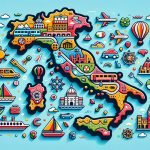Is it easy to travel around Italy? Italy is a country that boasts an abundance of natural beauty, rich history, and vibrant culture. From the picturesque coastal towns to the historic cities filled with iconic landmarks, Italy is a traveler’s paradise.
In this article, we will explore the various transportation options available for exploring this stunning country, including the efficiency of Italy’s railway system, navigating public transportation, driving tips, accessibility for tourists with disabilities, and the charm of walking tours in Italian cities. Whether you’re on a budget or looking to explore remote locations and islands, Italy offers numerous opportunities for exploration and adventure.
Italy offers a wide range of transportation options for travelers looking to explore its diverse landscapes and attractions. From trains to ferries, buses to walking tours, there are numerous ways to experience all that Italy has to offer. In this article, we will delve into how each mode of transportation can enhance your travel experience in Italy.
The efficiency of Italy’s railway system is renowned for making it easy for travelers to navigate the country. With an extensive network connecting major cities and smaller towns, taking the train allows for convenient and scenic travel throughout Italy.
Additionally, public transportation systems in urban areas provide visitors with access to historical sites and cultural hubs. For those looking for flexibility in their exploration, driving in Italy also presents its own set of tips and tricks for navigating the roads and making the most of your journey.
Overview of Transportation Options in Italy
Italy offers a wide range of transportation options for travelers looking to explore the country. From efficient railway systems to extensive public transportation networks, getting around Italy is relatively easy and convenient. In this section, we will provide an overview of the different transportation options available in Italy and how they contribute to making travel within the country accessible and enjoyable.
One of the most popular modes of transportation in Italy is its efficient railway system. The country’s network of trains connects major cities and towns, making it easy for travelers to explore various destinations without the hassle of driving or navigating unfamiliar roads. With high-speed trains such as the Frecciarossa, travelers can move quickly between cities like Rome, Florence, Venice, and Milan, allowing for a seamless travel experience.
In addition to trains, Italy also boasts a comprehensive public transportation system that includes buses, trams, and metro services in major urban areas. These options are not only convenient for getting around within cities but also provide connections to more remote locations and tourist attractions.
Travelers can easily purchase tickets or passes for these services, making it simple to navigate Italian cities without the need for a car. Overall, Italy’s diverse transportation options make it easy for visitors to move around the country comfortably and affordably.
| Transportation Option | Advantages |
|---|---|
| Railway System | Efficient, connects major cities |
| Public Transportation | Convenient within cities and provides access to remote locations |
The Efficiency of Italy’s Railway System
Italy’s railway system is known for its efficiency and connectivity, making it an easy and convenient way to travel around the country. With an extensive network that covers major cities, towns, and even remote areas, the Italian train system is a popular choice for both locals and tourists.
One of the main advantages of traveling by train in Italy is the speed and frequency of services. High-speed trains like the Frecciarossa can reach speeds of up to 186 mph (300 km/h), allowing passengers to quickly move between major cities such as Rome, Florence, Venice, and Milan. Additionally, there are regional trains that connect smaller towns and villages, providing access to lesser-known destinations.
For tourists exploring Italy, the country offers various rail passes that cater to different travel needs. The Eurail Italy Pass is ideal for non-European residents who want unlimited train travel within a set number of days, while the Trenitalia Pass provides flexible options for both domestic and international travelers. These passes can be cost-effective for those planning to visit multiple cities during their trip.
Overall, Italy’s railway system offers convenience, affordability, and efficiency for travelers of all kinds. Whether you’re looking to explore iconic landmarks or venture off the beaten path, taking the train is a practical and enjoyable way to experience the beauty of Italy.
| Advantages | Examples |
|---|---|
| Speed and Frequency | High-speed trains like Frecciarossa |
| Rail Pass Options | Eurail Italy Pass and Trenitalia Pass |
Navigating Italy’s Public Transportation Systems
When it comes to navigating Italy’s public transportation systems, visitors have a variety of options to choose from. From buses and trams to the metro and water taxis, Italy offers an extensive network of public transportation that makes getting around the country convenient and cost-effective.
Understanding the Different Modes of Transportation
Italy’s public transportation system consists of a combination of buses, trams, metro trains, and water taxis. Each mode of transport serves different areas within cities and regions, offering visitors flexibility in their travel plans. The availability of these options makes it easy for travelers to explore Italy’s diverse landscapes and cultural attractions.
Tips for Using Public Transportation in Italy
For tourists looking to utilize public transportation in Italy, there are a few key tips to keep in mind. First, it is important to familiarize yourself with the ticketing system for each mode of transport as they may vary from city to city. Additionally, understanding the schedules and routes can help prevent any confusion or delays during your travels. Finally, always be aware of pickpockets and keep an eye on your belongings while using public transportation in any Italian city.
Benefits of Public Transportation
Opting for public transportation is not only convenient but also practical for those looking to reduce their carbon footprint while exploring Italy. It provides an opportunity for visitors to meet locals and immerse themselves in the vibrant culture of the country. Utilizing public transportation is also often more cost-effective than renting a car or using other private modes of transport.
Overall, navigating Italy’s public transportation systems offers travelers the chance to experience the country like a local while easily getting around its cities and regions. Whether you’re heading to iconic landmarks or off-the-beaten-path destinations, using public transport
Driving in Italy
When it comes to traveling around Italy, many visitors choose to rent a car to be able to explore the country at their own pace. Before hitting the road, it’s essential to familiarize yourself with some tips and tricks for driving in Italy to ensure a smooth and enjoyable experience. Here are some important considerations to keep in mind:
- Know the rules of the road: It’s crucial to understand the driving laws and regulations in Italy before embarking on your journey. For example, in Italy, you drive on the right side of the road, and seat belts are mandatory for all passengers.
- Be prepared for narrow roads and tight parking: Many cities and towns in Italy are characterized by narrow streets and limited parking spaces. It’s important to be comfortable navigating through tight spaces and consider renting a smaller car to make maneuvering easier.
- Stay alert and confident: Italian drivers are known for their assertive driving style, so it’s essential to stay focused, assertive, and confident while behind the wheel. Be prepared for fast-paced traffic and frequent lane changes.
Traveling around Italy on a budget might also influence your decision to drive. While public transportation is generally affordable, having a car allows you the flexibility to visit more remote locations not easily accessible by train or bus. Additionally, splitting the cost of gas between travel companions can make driving a cost-effective option.
Ultimately, whether you choose to drive or rely on other forms of transportation during your time in Italy will depend on your preferences and specific travel itinerary. With careful planning and consideration of these tips, driving in Italy can provide an exciting way to explore this beautiful country at your own pace.
Accessibility for Tourists With Disabilities
Italy is known for its rich history, stunning architecture, and delicious cuisine, making it a popular destination for travelers from around the world. However, one important aspect that is often overlooked when planning a trip to Italy is the accessibility for tourists with disabilities. Despite its historical infrastructure, Italy has made significant progress in improving accessibility for individuals with disabilities.
In recent years, the Italian government has implemented various initiatives to make tourist attractions, public transportation, and accommodations more accessible. Many museums, historical sites, and landmarks have been renovated to provide ramps, elevators, and accessible restrooms for visitors with mobility issues. Additionally, many hotels and restaurants now offer facilities and services tailored to the needs of guests with disabilities.
When it comes to transportation options in Italy, travelers with disabilities will find that many train stations are equipped with elevators and ramps, making it easier to navigate the country’s efficient railway system. Most major cities also have accessible public transportation options such as buses and trams with designated spaces for wheelchair users.
Overall, while there are still challenges in some areas of Italy when it comes to accessibility for tourists with disabilities, the country has made significant improvements in recent years. With proper planning and research, travelers with disabilities can still enjoy all that Italy has to offer. From historical landmarks to picturesque landscapes and delectable cuisine, Italy truly offers an unforgettable experience for all travelers.
The Charm of Walking Tours in Italian Cities
Italy’s cities are renowned for their rich history, stunning architecture, and charming cobblestone streets, making them perfect for exploring on foot. Walking tours in Italian cities offer a unique and immersive way to experience the culture, cuisine, and beauty of the country. Whether you’re strolling through the ancient streets of Rome, wandering the romantic canals of Venice, or exploring the artistic masterpieces of Florence, there are countless opportunities to discover hidden gems and local treasures on foot.
Benefits of Walking Tours
One of the greatest benefits of taking a walking tour in Italy is the opportunity to truly immerse yourself in the sights, sounds, and flavors of the city. Many tour guides are locals who are passionate about sharing their knowledge and love for their city with visitors. They can provide insider tips, historical anecdotes, and recommendations for hidden gems that you might not discover on your own.
Additionally, walking tours allow you to set your own pace and take in the breathtaking scenery at your leisure. You can stop to savor a gelato at a quaint café, explore a charming neighborhood market, or capture stunning photos of iconic landmarks from unique vantage points. Walking tours also provide opportunities to interact with locals and fellow travelers, creating memorable experiences and connections.
Guided vs. Self-Guided Tours
When it comes to walking tours in Italian cities, travelers have the option to choose between guided tours led by knowledgeable locals or self-guided exploration using maps or mobile apps. Guided tours often provide a more in-depth understanding of the city’s history, art, and culture while offering personalized recommendations based on your interests. On the other hand, self-guided tours allow for greater flexibility and independence in creating your itinerary while still benefiting from informative resources.
Exploring an Italian city on foot allows visitors to fully appreciate the intricate details of architectural marvels such as cathedrals, palaces, and historic landmarks. Not only is it easy to travel around Italy by foot within its captivating cities but doing so also provides an authentic and enriching travel experience.
Is It Easy to Travel Around Italy on a Budget?
Traveling around Italy can be an affordable adventure, with a variety of budget-friendly transportation options and accommodations available to tourists. Here are some tips and suggestions for exploring the beautiful country of Italy without breaking the bank:
1. Utilize Italy’s extensive railway system: Italy is known for its efficient and extensive railway network, making it easy to travel between cities and regions at a reasonable cost. Purchasing a Eurail pass or regional train tickets can offer significant savings for budget-conscious travelers.
2. Opt for budget accommodations: Italy offers a wide range of affordable accommodation options, including hostels, guesthouses, and budget hotels. Booking in advance and considering alternative lodging options such as agriturismos or Airbnb rentals can help keep costs down.
3. Take advantage of budget-friendly activities: Many of Italy’s most famous attractions, such as the Colosseum in Rome or the Leaning Tower of Pisa, offer discounted admission or free entry on certain days of the week. Additionally, exploring charming local markets, parks, and public squares is a great way to experience Italian culture without spending a lot of money.
4. Enjoy affordable dining options: Sampling delicious Italian cuisine doesn’t have to break the bank. Eating at local trattorias and pizzerias, where you can enjoy authentic dishes at reasonable prices, is a great way to experience the local food scene without overspending.
By taking advantage of these budget travel tips and options, exploring the beauty of Italy on a limited budget is definitely feasible – allowing travelers to experience all that this stunning country has to offer without breaking the bank.
Exploring Italy’s Islands and Remote Locations
Italy is undoubtedly one of the most picturesque and captivating countries in the world, boasting a diverse landscape that includes stunning islands and remote locations. From the enchanting Sicily in the south to the breathtaking Amalfi Coast and the secluded villages of Cinque Terre, Italy’s islands and remote locations offer travelers a unique and unforgettable experience.
When it comes to traveling to Italy’s islands, such as Sardinia and Capri, there are several transportation options available. Ferries and boats are the most common modes of transportation to reach these destinations. While some islands have airports with regular flights, ferry rides are often preferred by travelers looking to enjoy stunning views of the Mediterranean Sea.
For travelers seeking adventure and exploration in Italy’s remote locations, reliable transportation options are essential. Whether it’s reaching mountain towns like Cortina d’Ampezzo or visiting the scenic countryside of Tuscany, rental cars provide the flexibility needed to navigate remote areas at your own pace. Additionally, organized tours and private transfers offer hassle-free ways to access these off-the-beaten-path destinations.
Exploring Italy’s islands and remote locations offers an escape from the bustling cities and allows travelers to immerse themselves in natural beauty and authentic Italian culture. Whether traveling by ferry to an island paradise or embarking on a road trip through picturesque countryside, experiencing these lesser-known gems is an essential part of any Italian adventure.
With a variety of transportation options available, getting around Italy from its islands to its quaint villages is indeed easy for those seeking a more off-the-beaten-path experience.
Conclusion
In conclusion, Italy truly lives up to its reputation as a traveler’s paradise. With its efficient railway system, extensive public transportation options, and the charm of walking tours in its beautiful cities, getting around the country is incredibly easy. Whether you’re traveling on a budget or seeking to explore the remote locations and islands of Italy, there are plenty of accessible and affordable transportation options available.
Italy’s railway system is not only efficient but also offers stunning views of the countryside, making it a delightful way to travel between cities. Navigating through public transportation systems in major cities like Rome and Florence is also relatively easy, with an abundance of buses and trams connecting different parts of the city. For those who prefer driving, despite the chaotic traffic and narrow streets, driving in Italy can be an exhilarating experience with proper planning and local knowledge.
For tourists with disabilities, Italy has made significant strides in improving accessibility across all forms of transportation. Many attractions, hotels, and public spaces have been designed to cater to individuals with mobility challenges, ensuring that everyone can experience the beauty of Italy. With all these factors combined, it is clear that Italy offers a seamless travel experience for visitors from all walks of life.
Frequently Asked Questions
What Is the Easiest Way to Get Around Italy?
The easiest way to get around Italy is by using the country’s extensive train system. Trains offer a convenient and efficient mode of transportation, connecting major cities and smaller towns.
Is It Hard to Travel Within Italy?
Traveling within Italy is not hard, especially if you stick to using trains or buses. The transportation infrastructure in the country is well-developed, making it relatively easy to move between different destinations.
How Many Days Do You Need to Travel Through Italy?
The number of days you need to travel through Italy depends on your itinerary and the places you want to visit. A minimum of 7-10 days is recommended to cover at least the major highlights like Rome, Florence, Venice, and perhaps a smaller city like Siena or Bologna.
However, ideally, giving yourself 2-3 weeks will allow for a more relaxed exploration of the country’s diverse regions and attractions.

I’m a passionate traveler, writer, and Italophile. My fascination with Italy’s history, art, and culture has led me on countless adventures across the Italian landscape. Through “I Live Italy,” I share my love for this extraordinary country and aims to inspire others to explore its boundless beauty.





